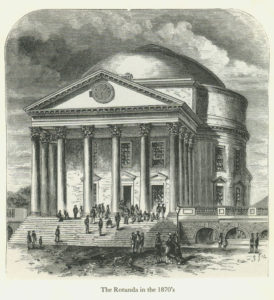 By Peter Galuszka
By Peter Galuszka
Virginia residents have long enjoyed a special advantage with higher education. Tuition at some of the country’s best-rated public universities — the University of Virginia, the College of William and Mary and Virginia Tech — is relatively modest. The schools offer a great deal for parents and students compared with nationally ranked private colleges.
But this advantage is unraveling. The process began seven years ago, when the General Assembly agreed to a deal whereby it would pay not as much for top public universities. In exchange, the schools would get more autonomy, including more freedom to set their own tuitions, capital spending programs and curricula.
The result? A creeping privatization that threatens to undermine the very
advantages that make Virginia’s top public schools what they are.
To be sure, state education bureaucrats and legislators call it not “privatizing” but “restructuring.” This euphemism means the schools will
gradually demand tuition closer to what is charged at the top national, private institutions but won’t have to go through the hassle that true privatization would entail — such as the selling of public property and making good on repaying decades of public investment.
There is some logic to this approach: If Virginia’s elite public colleges
start approaching market rates for tuition, the thinking goes, state money could be freed up to spend on lesser institutions. More financial-aid money would become available. The state could use those resources to reach for its goal of 100,000 more students earning degrees. Since 2005, when the concept was formalized in General Assembly legislation, Virginia Commonwealth University added itself to the list of schools willing to trade funding for autonomy.
The same year that “restructuring” was approved, John T. Casteen II, then the president of U-Va., announced an ambitious campaign to raise $3 billion through fundraising. Most of that has been collected, although the effort to raise so much private money at a public school raised eyebrows. More recently, Taylor Reveley, president of William and Mary, proposed
bringing his school’s tuition levels to market rates, which, for a nationally rated private institution, would be about $45,000 a year for tuition, room and board. Out-of-state W&M students now pay $44,854 a year, while in-state students pay $22,024.
Reveley notes that Richmond provides only 13 percent of W&M’s funding,
which is way down from the 43 percent of 30 years ago. This trend has been even more pronounced at other elite Virginia public colleges. At the University of Virginia, the state pays less than 8 percent of what the school needs. At Tech, the process has been slower. In 2000, the state provided 58 percent of the school’s needs; today it’s 28 percent.
Reveley argues that if more in-state parents or students paid full freight,
then his school could offer more generous financial-aid packages to middle- and lower-income students. He also believes that as top schools become more self-sustaining, a second tier of Virginia schools could be given more state funding and raise their own academic standings. These would include Old Dominion, George Mason, James Madison, Radford, Longwood and the state’s community college system.
But there is cause to worry about this argument. At present, many complain that lower-income Virginians have been forced to compete with an increasing number of deep-pocketed out-of-staters, whose higher tuition helps to balance the schools’ books. As those schools look to capture more revenue via in-state tuition, they will face strong incentives to accept a greater portion of in-state students with the means to pay all or most of their own way. And even with increased aid, worthy but less affluent students will confront barriers. Some will simply opt for less expensive, less competitive schools; others will emerge from school more deeply in debt.
Such an uneven playing field is contrary to the spirit of a state-funded
higher education: Why should a kid from affluent Fairfax have a better chance at attending U-Va. or W&M than someone with the same grades and test scores from Big Stone Gap?
I’ve noticed this kind of elitism beginning to appear in “Virginia” magazine,
published by the school’s alumni association. Its pages are filled with four-color advertisements hawking multimillion estates mostly in blue-blood
horse country. The message that’s suggested? “If you can’t afford these kinds of properties, then maybe you don’t belong at Mr. Jefferson’s University.”
Privatization is thought of by Virginia conservatives and even some moderates as a panacea for addressing the state’s budget woes while adhering to the state’s dominant anti-tax ideology. Tax hawks, for instance, constantly dodge the need for higher taxes to pay for highways by tossing the problem over to public-private partnerships. But applying the same thinking to public higher education risks undermining the very purpose of such institutions — building the highly educated middle class needed to keep Virginia competitive nationally and globally.
A straight sell-off of state schools isn’t likely. What is possible, says
James Alessio, chief of higher education restructuring at the State Council for Higher Education, is a steady series of tuition hikes in the 5 to 7 percent range. “Within maybe 40 years, you’ll see tuition at the public schools go to $40,000 or $50,000,” he told me.
Once that happens, the stealthy, half-privatization of Virginia’s academic
jewels will be complete, and probably irreversible. One possible solution comes from the University of California at Berkeley, which announced this month that it will cap tuition at 15 percent of what “middle class” families make, defined as $80,000 to $140,000 a year.
Virginia could try something similar. Otherwise, on its current trajectory, the state is fast moving toward a two-tier public college system heavily based on income — the exact opposite of what public higher education is supposed to be.
First published in The Washington Post


